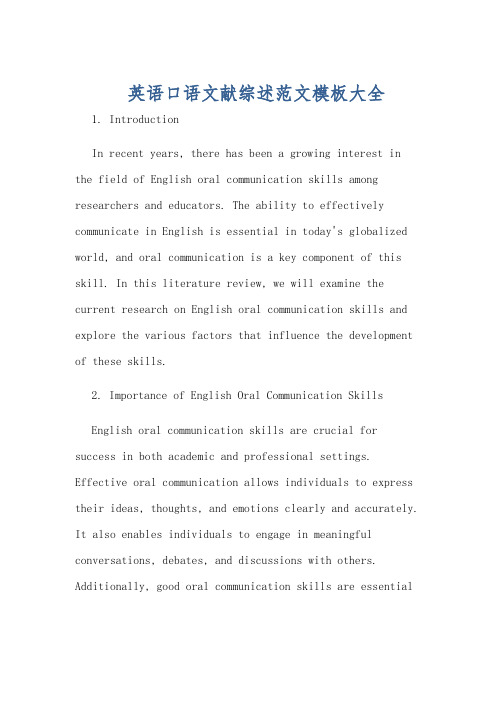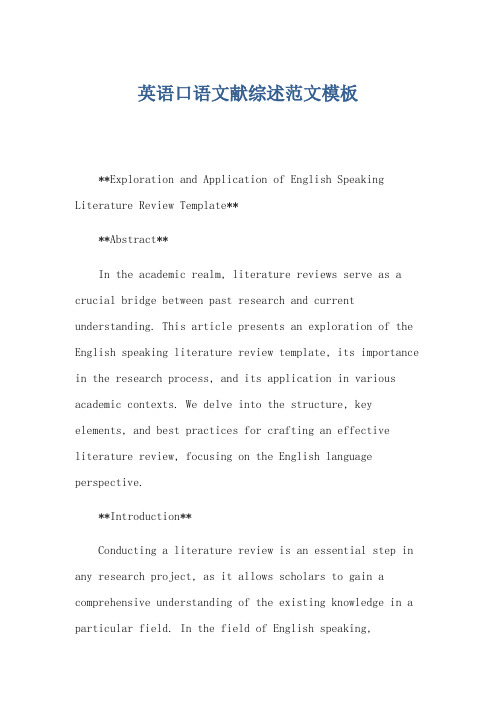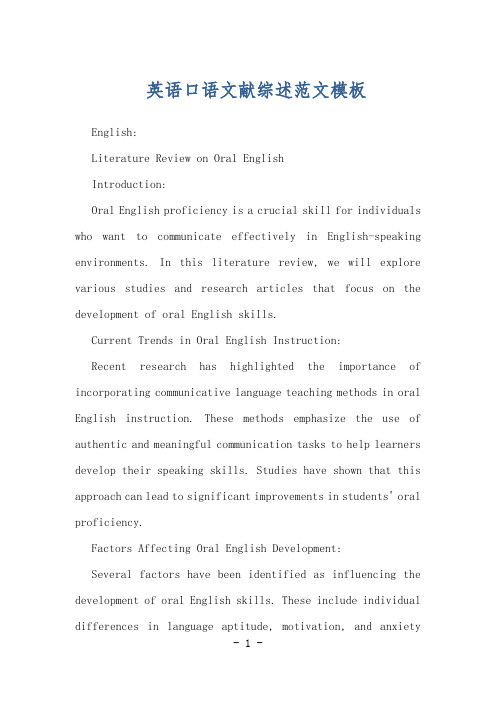口译笔记文献综述
英语笔译文献综述

英语笔译文献综述Here is an essay on the topic of "A Literature Review on English-Chinese Translation" with over 1000 words, written in English without any additional punctuation marks in the body of the text.The field of English-Chinese translation has been a subject of extensive research and study for decades. As the world becomes increasingly interconnected, the demand for accurate and effective translation services has grown significantly. This literature review aims to provide an overview of the current state of research in this field, highlighting key themes, methodologies, and areas for further exploration.One of the primary focuses in English-Chinese translation research has been on the linguistic and cultural challenges inherent in the process. Scholars have examined the differences in grammatical structures, idioms, and cultural references between the two languages, and how these disparities can impact the quality and accuracy of translations. Studies have explored strategies for navigating these challenges, such as the use of machine translation, the role of human translators, and the importance of cultural awareness and adaptation.Another area of research has been the impact of technological advancements on the translation industry. The rise of machine translation, computer-assisted translation tools, and cloud-based platforms has transformed the way translation services are delivered. Researchers have investigated the strengths and limitations of these technologies, as well as the implications for the role of human translators in the future. Additionally, studies have examined the ethical considerations surrounding the use of artificial intelligence in translation, such as issues of data privacy, bias, and the potential displacement of human workers.The quality and evaluation of English-Chinese translations have also been the subject of extensive research. Scholars have developed frameworks and methodologies for assessing the accuracy, fluency, and overall effectiveness of translations, taking into account factors such as linguistic equivalence, cultural appropriateness, and the intended purpose of the translation. These evaluation methods have been applied to a wide range of translation contexts, including literary works, technical documents, and business communications.Another area of focus in the field of English-Chinese translation is the training and professional development of translators. Researchers have explored the skills, knowledge, and competencies required for effective translation, and have investigated the bestpractices for educating and training translators. This includes the use of translation-specific curricula, the integration of technology into the learning process, and the importance of ongoing professional development and certification.In addition to these core areas of research, scholars have also examined the role of English-Chinese translation in various domains, such as international business, education, and healthcare. These studies have explored the unique challenges and considerations that arise in these specialized contexts, and have provided insights into the strategies and approaches that can lead to successful translations.Despite the significant progress that has been made in the field of English-Chinese translation, there are still many areas that require further research and exploration. For example, the impact of globalization and the increasing use of English as a lingua franca on translation practices is an emerging area of interest. Additionally, the ethical implications of translation, such as the potential for misrepresentation or the perpetuation of cultural biases, warrant deeper examination.Furthermore, the field of English-Chinese translation would benefit from more interdisciplinary collaboration, drawing on insights from fields such as linguistics, cognitive science, and cultural studies. By fostering a more holistic and multifaceted approach to translationresearch, scholars can gain a deeper understanding of the complexities and nuances involved in the process.In conclusion, the field of English-Chinese translation has been the subject of extensive research and study, yielding valuable insights into the linguistic, cultural, and technological challenges involved in the translation process. As the demand for translation services continues to grow, it is crucial that researchers and practitioners work together to advance the field, develop innovative solutions, and ensure the highest quality of translation services. By doing so, they can contribute to greater cross-cultural understanding and effective communication in an increasingly globalized world.。
英语口语文献综述范文模板大全

英语口语文献综述范文模板大全1. IntroductionIn recent years, there has been a growing interest in the field of English oral communication skills among researchers and educators. The ability to effectively communicate in English is essential in today's globalized world, and oral communication is a key component of this skill. In this literature review, we will examine the current research on English oral communication skills and explore the various factors that influence the development of these skills.2. Importance of English Oral Communication SkillsEnglish oral communication skills are crucial for success in both academic and professional settings. Effective oral communication allows individuals to express their ideas, thoughts, and emotions clearly and accurately. It also enables individuals to engage in meaningful conversations, debates, and discussions with others. Additionally, good oral communication skills are essentialfor building relationships, collaborating with others, and resolving conflicts.3. Factors Influencing English Oral Communication SkillsThere are various factors that can influence the development of English oral communication skills. These factors include individual characteristics (such as motivation, self-confidence, and language proficiency), social factors (such as cultural norms and communication styles), and contextual factors (such as the learning environment and teaching methods). Researchers have found that a combination of these factors can significantly impact an individual's ability to communicate effectively in English.4. Strategies for Improving English Oral Communication SkillsThere are several strategies that can help individuals improve their English oral communication skills. These strategies include practicing speaking regularly, engaging in conversations with native speakers, listening to English audio materials, watching English videos, and participating in language exchange programs. Additionally, takinglanguage courses, attending workshops, and receiving feedback from peers and teachers can also be beneficial in enhancing oral communication skills.5. Challenges in Developing English Oral Communication SkillsDespite the importance of English oral communication skills, many individuals face challenges in developingthese skills. Some common challenges include fear of speaking in front of others, lack of vocabulary and grammar knowledge, difficulties in understanding accents and intonation, and cultural differences in communication styles. Overcoming these challenges requires patience, practice, and perseverance.6. ConclusionIn conclusion, English oral communication skills are essential for success in today's globalized world. By understanding the factors that influence the development of these skills, implementing effective strategies for improvement, and overcoming challenges, individuals can enhance their ability to communicate effectively in English. Continued research in this area is necessary to furtherexplore the complexities of oral communication and to develop innovative approaches for enhancing these skills.。
英语口语文献综述范文模板

英语口语文献综述范文模板**Exploration and Application of English Speaking Literature Review Template****Abstract**In the academic realm, literature reviews serve as a crucial bridge between past research and current understanding. This article presents an exploration of the English speaking literature review template, its importance in the research process, and its application in various academic contexts. We delve into the structure, key elements, and best practices for crafting an effective literature review, focusing on the English language perspective.**Introduction**Conducting a literature review is an essential step in any research project, as it allows scholars to gain a comprehensive understanding of the existing knowledge in a particular field. In the field of English speaking,literature reviews are particularly crucial as they help researchers identify gaps in the literature, understand the evolution of ideas, and establish the context for their own work. The aim of this article is to provide a comprehensive template for conducting English speaking literature reviews, guiding researchers through the process and highlightingkey considerations.**The Importance of English Speaking LiteratureReviews**English speaking literature reviews play a pivotal role in the academic community. They not only summarize and synthesize existing research but also provide a critical analysis of the strengths and weaknesses of those studies. By conducting a literature review, researchers can ensure that their work is rooted in a solid foundation of knowledge, avoiding duplication and building upon the workof others. Furthermore, literature reviews help establish the research gap, identifying areas where further investigation is needed, thus guiding future research directions.**Structure of the English Speaking Literature Review Template**The English speaking literature review template follows a structured format, ensuring that all relevant information is included and organized in a logical manner. The template typically consists of the following sections:1. **Introduction**: This section briefly introduces the topic of the literature review, outlining the purpose, scope, and research questions. It also provides a background on the importance of the topic and its relevance to the field of English speaking.2. **Methodology**: Here, the researcher describes the methods used to collect and analyze the literature. This includes the search strategy, selection criteria, and any specific analytical tools or frameworks employed.3. **Literature Overview**: This section presents a comprehensive overview of the existing literature, summarizing the key findings and arguments made by previous studies. It aims to provide a broad understanding of the topic and its historical development.4. **Critical Analysis**: In this section, the researcher critically evaluates the literature, identifying strengthsand weaknesses, gaps in research, and areas of consensus or disagreement among scholars. This analysis helps to shape the research agenda and identify areas for further exploration. 5. **Conclusion**: The conclusion section summarizes the main findings of the literature review, highlights the research gap, and suggests directions for future research. It also reaffirms the significance of the topic and its potential to contribute to the field of English speaking.**Best Practices for Crafting an Effective English Speaking Literature Review**When crafting an effective English speaking literature review, it is important to follow certain best practices. These include:* **Clear and Concise Writing**: Literature reviews should be written in a clear, concise, and coherent manner, ensuring that the reader can easily follow the arguments and understand the key points. * **Critical Thinking and Analysis**: Literature reviews should involve critical thinking and analysis, going beyond a mere summary of existing studies. Researchers should evaluate the qualityof the literature, identify gaps in research, and make recommendations for future work. * **Use of Reliable Sources**: It is crucial to rely on reliable and peer-reviewed sources when conducting a literature review. This ensures that the information presented is accurate, credible, and relevant to the field of English speaking. ***Organized Structure**: A well-structured literaturereview helps the reader navigate through the content easily. Organizing the review by themes, subtopics, orchronological order can enhance readability and comprehension. * **Focus on the Topic**: While discussingthe literature, it is important to stay focused on thetopic of the review. Avoid straying into unrelated areas or tangents that do not contribute to the overall objective of the review.**Conclusion**The English speaking literature review template serves as a valuable tool for researchers seeking to synthesizeand analyze existing knowledge in the field. By followingthe structure and best practices outlined in this article, researchers can craft effective literature reviews thatcontribute to the advancement of knowledge and guide future research directions. The template not only facilitates the organization and presentation of information but also promotes critical thinking and analysis, essential skillsfor any researcher working in the field of English speaking. **中文内容****英语口语文献综述范文模板的探索与应用****摘要**在学术领域,文献综述是连接过去研究与当前理解的重要桥梁。
英语口语文献综述范文模板

英语口语文献综述范文模板English:Literature Review on Oral EnglishIntroduction:Oral English proficiency is a crucial skill for individuals who want to communicate effectively in English-speaking environments. In this literature review, we will explore various studies and research articles that focus on the development of oral English skills.Current Trends in Oral English Instruction:Recent research has highlighted the importance of incorporating communicative language teaching methods in oral English instruction. These methods emphasize the use of authentic and meaningful communication tasks to help learners develop their speaking skills. Studies have shown that this approach can lead to significant improvements in students' oral proficiency.Factors Affecting Oral English Development:Several factors have been identified as influencing the development of oral English skills. These include individual differences in language aptitude, motivation, and anxietylevels. Research has also shown that the amount and quality of input, as well as opportunities for practice, play a crucial role in oral English development.Technology in Oral English Learning:The use of technology in language learning has become increasingly popular in recent years. Online platforms, mobile apps, and virtual reality tools can provide additional opportunities for students to practice their oral English skills outside of the classroom. Research has shown that these technological tools can be effective in enhancing students' speaking abilities.Assessment of Oral English Proficiency:Assessing oral English proficiency can be challenging, as it involves evaluating a range of skills such as fluency, accuracy, vocabulary, and pronunciation. Traditional assessment methods, such as interviews and oral exams, have limitations in terms of reliability and validity. Researchers have been exploring alternative assessment approaches, including performance-based tasks and self-assessment tools.Conclusion:In conclusion, developing oral English proficiency is essential for effective communication in English. Theliterature review has highlighted the importance of communicative language teaching methods, individual factors, technology, and assessment in oral English instruction. Future research should continue to explore innovative approaches to help learners improve their speaking skills.中文:口语英语文献综述介绍:口语英语能力对于希望在英语环境中有效交流的个人来说至关重要。
外事口译笔记总结[合集5篇]
![外事口译笔记总结[合集5篇]](https://img.taocdn.com/s3/m/2d71c95c001ca300a6c30c22590102020740f229.png)
外事口译笔记总结[合集5篇]第一篇:外事口译笔记总结外事口译笔记总结简历1.姓名 NameLinghu Chong,Zhuge Liang(复姓写在一起),Lee 或Lih (李),Lu(吕)2.性别 GenderFemale,male3.年龄 DOB(Date of Birth)month/day/year4.籍贯 Hometown5.文化程度 Education Background6.学位 Degree7.职务Position/Title8.职称T echnical Title9.工作单位Employer政治词汇翻译中共中央 The CPC Central Committee中央委员 member of the CPC Central Committee中央政治局the Political Bureau of the Central Committee政治局委员member of the Standing Committee of Political Bureau of the CPC全国人大National People’s CongressProvincial/Municipal/Town/T ownship(乡)People’s Congress 人大代表deputy to政协Chinese People's Political Consultative Conference (Hereinafter referred to as CPPCC/called CPPCC for short)政协主席 Chairman of the National Committee of the CPPCC 中共河南省委 The CPC HN Provincial Committee书记 Secretary总书记 general secretary秘书长 secretary in general6.省政府Provincial People’s Government河南省长Governor of HN Provincial People’s Governmen t 河南省人民政府常务副省长executive vice-governor of HN Provincial People’s Government 河南省委常委the Standing Committee of the HN Provincial Government7.国务院 The State Council国务院总理 the Premier of the State Council of the PRC8.中华人民共和国主席president of PRC各部门政府办公厅General Office(主任director 副主任deputy of director)教育厅 Education Department科学技术厅 Science and Technology Department工业和信息化厅Industry and Information Technology Department民族事业委员会 Ethnic Affairs Commission公安厅 Public Security Department住房与城乡建设厅 Housing & Urban and Rural Construction Department交通运输厅 Transportation Department水利厅 Water Resources Department农业厅Agriculture Department林业厅Forestry Department商务厅 Commercial Department文化厅 Culture Department卫生厅 Public Health Department国家安全厅 State Security Department监察厅 Supervision Department民政厅 Civil Affairs Department司法厅Justice Department财政厅Finance Department人力资源和社会保障厅Human Resources and Social SecurityDepartment 国土资源厅 Land and Resources Department 环境保护厅Environment Protection Department审计厅 State Auditing Department人口和计划生育委员会 Family Planning Committee发展与改革委员会 Development and Reform Committee政府外事侨务办公室Foreign and Overseas Chinese Affairs Office of(Henan Province)地方税务局 Local Tax Bureau 工商行政管理局Administration for Industry an Commerce质量技术监督局Quality and Technical Supervision Bureau广播电影电视局 Broadcasting,Movie and TV Bureau新闻出版局 Information and Publication Bureau体育局 Sports Bureau统计局 Statistics Bureau旅游局 T ourism Administration粮食局 Grain Bureau常用的外事词汇全自动automatic 半自动 semi-automatic降水量 precipitation107国道 No.National Highway对外联络处 International Office美国对华贸易商 American China Trader对华政策 China policy高新技术 new –high tech(technology)皇帝 Yellow Empire 炎帝 Empire Yan 汉族 Ethnic Han大专 junior college 中专 technical secondary school可持续发展 sustainable development环保 environment friendly物质文明精神文明material progress and cultural progress星级酒店 star-rated hotel集于一体 merge-into a single whole董事长 board chairman首席执行官 CEO(chief executive officer)中国人民对外友好协会Chinese People’s Association for Friendship with Foreign Countries.第二篇:外事口译副总统阁下、威廉斯夫人,Your Excellency Vice President and Mrs.Williams, 贵宾们,Distinguished Guests 女士们、先生们:Ladies and Gentlemen,我为能在此设宴招待威廉斯副总统和夫人以及其他贵宾而深感荣幸和愉快。
近十年_2002_2011_中国口译研究状况综述_高杰 (1)

1前言近年来,口译活动逐渐增多,针对口译的研究也受到越来越多学者们的重视,口译研究成果也不断丰富。
李向东(2007)曾经对70年代末到2006年2月间发表的口译研究论文进行过主题分类及趋势研究,除此之外,尚未找到类似的口译论文综述研究。
本文以《中国翻译》、《中国科技翻译》、《上海翻译》和《东方翻译》四本具有权威性和代表性的翻译类研究杂志上2002-2011十年间发表的167篇关于口译研究的文章为研究样本,采用定性研究和定量研究相结合的方法,从论文发表数量、研究方向、作者地域分布三个方向来分析近十年中国口译研究的发展状况及趋势。
2数据分析2.1发表数量四大翻译类杂志2002-2011年口译相关论文发表数量及论文年份分布可见表一。
(《东方翻译》2009年建刊,故2002-2008年的统计数据空缺)。
表格一年份篇数刊名中国翻译中国科技翻译上海翻译东方翻译合计026551603663150485316056331206464140710932208522909924419108619241193820合计71473613167由表可见,《中国翻译》和《中国科技翻译》为国内口译论文发表的主要刊物,2002-2011十年间,发表在《中国翻译》上的论文总数占到发表在四大翻译杂志论文总数的42.5%,发表在《中国科技翻译》上的论文总数占28.1%。
此外,《中国翻译》杂志每年口译论文的发表数量基本都居首位。
值得注意的是,2006-2009年期间,四大杂志上发表的口译文章数量波动较大,其中2006-2007年,发表文章数量涨幅为57%,为历年最高;经历了2008年的剧烈下滑后,2009年恢复正常水平,变化趋势整好于这段期间的国际经济震荡趋势相吻合。
由此可见,口译研究受到国际经济发展,国际交流活动频繁程度的影响。
2.2研究方向目前,学术界对口译研究方向的分类问题尚未达成一致,分类方法也是五花八门。
通过仔细阅读所收集到的167篇文章,笔者发现引用最广泛的口译研究分类方法有两种:刘和平(2005)提出的分类方法和胡庚申和盛茜(2000)提出的分类方法。
口译笔记综述

笔记功能笔记的原则(考量口译的目的、译者的工作负荷、工作环境而订定的纲领。
)1. 脑记为主,笔记为辅。
脑记大意,笔记细节译者应以听看讲者,全面地吸收讯息、组成口译讯息为工作主体,笔记只是辅助的作用,不宜舍本逐末。
2. 记下密度与难度高的信息。
信息负荷过量且不易记住的内容(如数字、专有名词),一定要做笔记。
5W1H「六何」(何人、何事、何时、何地、何物、如何)。
再加上,数字与专有名词就是了讯息内容之间的关系口译笔记的内容主要是:概念、命题、名称、数字、组织机构和逻辑关系(如大小、先后、正反、上下、升降、因果关系等),笔记单位以表达意群的词语和符号为主。
3 母语记录为主4. 笔记的语言符号,必须能够沟通。
译者应避免使用自己不熟悉的符号,或是双人合作时应避免字迹凌乱。
5. 笔记的内容与符号,以多重利用为原则。
任何已记下的笔记内容与符号,都应尽量拉线再次利用,或用不同颜色的笔在原来的笔记上再做笔记,以最经济的方式发挥笔记的作用到极限。
6.纵向记录当语篇信息密集且并列较多的时候,要尽量采用纵向记录,提高记录速度和分辨速度7.符号使用笔记法符号的确定是因人而异的,只要用自己习惯的缩语表示复杂意思就行,不是要死背,但是符号的形成方法还是有规可依。
A笔记法专用符号:口译中的高频词有专门归纳的笔记符号可以应用,其实那些别人在用的自己也能很快适应的符号都能搬来为己所用。
另外,if(如果)、tel(电话)、FOB(离岸价)这样普遍理解的词,作为俗成的符号也能归为此类。
B习惯练就的符号:按自己表述的思维,在平时练习给复杂的字词或意思配备表示符号,完全个性化,绝招无止境~C临时节选的符号:这种方法最好配合B共同练习使用,这样更为灵活,在口译时也更易准确看懂自己笔记的意思。
当然,在口译时用不用笔记法,记忆、笔记、理解、翻译,各自调用多少大脑细胞,还是要各人经过自我训练,熟能生巧后自成一派才行,没有一定的标准。
意群提升了我们的记忆单元,大大加强了我们对英语句子的把握。
口译焦虑文献综述

口译焦虑文献综述摘要:口译焦虑是指在口译过程中产生的一种情绪体验,它可能对口译质量和表现产生负面影响。
本文通过对相关文献的综述,探讨口译焦虑的定义、特征、影响因素以及应对策略。
研究发现,口译焦虑是一种普遍存在的现象,其特征包括身体不适、心理压力和注意力分散等。
影响因素包括个体因素、任务因素和环境因素。
为了应对口译焦虑,研究者提出了多种策略,如认知重构、情绪调节和训练技巧等。
未来的研究可以进一步探讨口译焦虑的机制和有效的干预方法,以提高口译的质量和效果。
关键词:口译焦虑、特征、影响因素、应对策略一、引言随着全球化的发展和国际交流的增加,口译作为一种重要的跨文化交际方式得到了广泛应用。
然而,口译过程中常常伴随着焦虑情绪,这可能对口译质量和表现产生负面影响。
因此,研究口译焦虑并寻找有效的应对策略具有重要意义。
二、口译焦虑的定义与特征口译焦虑是指在口译过程中产生的一种情绪体验,包括对任务的担心、紧张和不安。
口译焦虑的特征主要包括身体不适、心理压力和注意力分散。
研究表明,口译焦虑可能对口译者的记忆、注意力和思维加工能力产生负面影响。
三、口译焦虑的影响因素口译焦虑的影响因素可以分为个体因素、任务因素和环境因素。
个体因素包括个体的性格特点、自信心和经验等;任务因素包括任务的难度、压力和时间限制等;环境因素包括评价机制、观众压力和工作环境等。
这些因素之间相互作用,共同影响着口译者的焦虑水平。
四、口译焦虑的应对策略为了应对口译焦虑,研究者提出了多种应对策略。
认知重构是一种常用的策略,通过改变口译者对焦虑的认知方式来减轻焦虑情绪。
情绪调节策略包括深呼吸、放松训练和自我暗示等,可以帮助口译者控制情绪状态。
此外,训练技巧如模拟训练、反馈和自我评估等也被认为是有效的应对策略。
五、结论与展望口译焦虑是一种普遍存在的现象,对口译质量和表现有负面影响。
个体因素、任务因素和环境因素是口译焦虑的影响因素。
为了应对口译焦虑,认知重构、情绪调节和训练技巧等策略被广泛应用。
- 1、下载文档前请自行甄别文档内容的完整性,平台不提供额外的编辑、内容补充、找答案等附加服务。
- 2、"仅部分预览"的文档,不可在线预览部分如存在完整性等问题,可反馈申请退款(可完整预览的文档不适用该条件!)。
- 3、如文档侵犯您的权益,请联系客服反馈,我们会尽快为您处理(人工客服工作时间:9:00-18:30)。
国内外口译笔记研究综述口译,是通过口译员在极其有限的时间内,听辨原语,进行理解和解码(即建立意义单位,脱离语言外壳,从整体上把握信息),然后进行信息储存(脑记辅以笔记),再在头脑中转换信息,进行信息编码,最后创造性地用目标语“复述”给受众的一个过程。
口译的时间性和加工过程的复杂性,要求译员熟练的掌握各种专业技能,而口译笔记就是即席传译(交替传译)中必须掌握的一种(吴钟明,2008:1)。
口译笔记法是口译员在紧张的会场气氛中,在不干扰听辨源语的情况下,迅速地以简便的符号、文字等记录讲话重点内容信息的一种笔记方法。
他只需要记录重点语义信息点和语言逻辑结构。
简单来说,它是由符号、文字加上斜线以及并列符、连接符和趋向符等来体现句与句之间的逻辑关系(吴钟明,2008:1)。
口译笔记能对大脑短时记忆起到很好的辅助作用和提示作用。
其重要性主要体现在,它能有效地减轻译员大脑的负担,弥补其短时记忆的不足。
另外,口译中做笔记的过程也是一个很好的思维整理过程,有助于译员把被动记忆转化为主动记忆,提高口译记忆的效率(王斌华,2006:26)。
Danica Seleskovitch在对比“字面直译”和“反思性翻译”的基础上提出了“脱离语言外壳”的理念,成为巴黎学派的“释意理论”的源头(仲伟合,2012:28)。
他和Marianne Lederer于20世纪70年代提出了释意理论,构建了一个“口译三角模型”,强调译员在理解的过程中应“脱离语言外壳”,抓住意义(仲伟合,2012:30,77)。
20世纪90年代以来,以Gile(1990;1994a,1994b)为代表的不少学者开始质疑释意理论,认为其研究方法缺乏实证性的检验,研究路径缺乏与相关学科的互动交流,术语界定过于模糊(仲伟合,2012:35)。
Gile(1995/2011)构建了交替传译和同声传译“认知负荷模型”假说,指出了两个可能导致口译过程中出现认知处理问题的触发原因:一个事单个任务的精力分配不够;二是任务总和的认知负荷接近饱和水平。
从理论的经验层面来看,该假说可以用于解释一些口译的策略,如笔记要力求精简,记录过程尽量自动化,以求单个任务所占用的精力少一些(仲伟合,2012:36-37)。
根据在CNKI和web of science上搜索得到的数据,1995年至2014年间,国内共发表口译(英汉)笔记研究方面的论文125篇,国外共发表论文8篇(目前图书馆资源只有这么多),研究内容主要集中在以下4个方面:口译笔记技巧与策略,口译笔记教学,口译笔记理论和口译笔记发在其他英语教学领域的中的应用。
这里主要叙述口译笔记技巧与策略和笔记教学。
1.笔记技巧与策略主要归纳和总结了笔记的语言,格式,方法,工具,符号和缩略语等的使用,这方面的研究是口译笔记研究者最先涉足的领域,主要是整和他人研究成果和经验总结:笔记语言方面:传统上,笔记语言研究关注“使用原语记录”还是“使用目的语记录”。
赞成使用目的语记录的理由:第一,这样做可以迫使译员脱离原语的语言表层结构,抓住深层意思; 第二,这样做可以提高译文产出的速度和质量。
提倡使用原语记录的理由:第一,在记笔记时进行语言转换会增加译员听辨阶段的认知负荷,影响其他过程的顺利进行; 第二,在语境不充分的情况下,译员理解可能出现偏差,而如果使用目的语记笔记,记下的意思可能会需要再回头进行修改,反而会影响笔记过程。
Dam提出了全新的观点,认为笔记语言与口译任务中的语言组合( 原语或目的语) 关系不大,主要与译员本身的语言组合( A 语或 B 语) 有关,其中主导笔记语言的是译员的 A 语(原语)。
这一观点的提出给笔记语言研究提供了一个新的角度。
而 Csilla Szabo使用同样的分类却得出与 Dam 截然相反的结论,认为主导笔记语言的是译员的 B 语(目的语)。
戴炜栋、徐海铭对比了职业受训译员和非职业受训译员的笔记原稿,发现职业受训译员笔记中使用的原语数量不如非职业受训译员多,但使用的目的语数量比非职业受训译员多。
徐琦璐通过实验得出结论: 主导译员笔记语言的是B 语。
邓玮通过观察得出结论: 交传笔记语言呈现明显的 A 语倾向性。
另外,国内研究人员认为应该记录关键信息( 关键词) 、专有名词、数字、地名、人名,而何为“关键信息”却一直没有定论。
有人认为“关键信息”就是“主语、谓语、宾语”; 有人认为应该记主语和动词; 有人提出记主语和宾语即可; 还有人提出介词也属于关键信息,需要记录。
比如王锦程在《英汉口译中笔记的特点及其方法》中提出口译笔记应该记数字,专有名词,专业名词等,脱离原语的语言外壳,用目的语加符号记录;左嘉认为主位结构理论也为口译速记提供了一定的方法论指导, 使译员在信息量大的话语语篇时, 从宏观上把握语篇的间架结构, 采用网状式的整体记录, 避免点状式的局部记录, 使口译笔记更加重点突出、简明扼要、层次分明。
苏跃和张晔在《谈口译中的笔记技能操控》中总结了口译笔记的策略:笔记应该呈阶梯式排列,纵向分页,横向分段,采用条列式记法; 符号和缩略语的使用是笔记的一大特征,方便译员“眼见笔记,口出译文”; 笔记是可以目的语,来源语双语并用。
笔记本身因人而异,但也有共性,现在的技巧研究还未解决学界一直有争议的问题,建议在这方面能有更加科学,系统的实证研究。
2.笔记教学涉及教学理念、方法、问题等教学基本内容,同时也会涉及到一些笔记技巧的一般性介绍。
在笔记的教学顺序,即“笔记训练应于信息理解加工训练或记忆强化训练之后进行”这一点上,也无异议,比如赵颖从ACT-R理论谈英语本科生口译笔记能力的培养,得出从阅读笔记开始循序渐进地培养学生的笔记能力并逐渐过渡到听译过程中自然的笔记系统对口译教学和学生口译能力的自主发展很有借鉴意义。
笔记的教学内容应包括理论讲解和实践两部分。
理论讲解除了帮助学生形成关于笔记必要性、作用、特征、原则等的理论框架外,还有必要向学生介绍一些常见的笔记符号。
在教学方法上,国内笔记教学研究基本局限于传统的笔记教学法,即教师讲解基本原则,学生练习,教师点评和示范,学生巩固练习。
这样的笔记学习实际上是学生对教师笔记的模仿,抑制学生创造力和想象力的发挥,不利于学生形成自己的符号体系。
学生笔记质量直接取决于教师的笔记质量,且上课效率较低。
杨晓辉、于英杰首次提出依托虚拟现实技术平台的日语口译笔记训练方法,对传统的笔记教学方法进行了创新。
国内还有研究人员对于学生笔记学习中常遇到的问题进行总结,但并未提出操作性强的解决方法。
除了研究不够系统之外,国内的笔记教学研究还忽略了一个重要的方面: 教学评估。
到底应该对笔记实施以产品为导向( product - oriented) 还是以过程为导向( process - oriented) 的评估? 现在提到的对学生笔记的点评都属于以产品为导向的评估,只关注学生笔记的最终版本。
通过结合技术手段对笔记实施以过程为导向的评估,同时参照学生笔记过程和原语信息发布,可以更好地认识笔记的认知过程。
比如朱巧莲,张楠展开了礼仪类口一种预测作用的实证研究,提出预测对译员来说是一项重要的技能, 因为它能优化理解阶段的信息处理模式和口译笔记, 从而提高口译成效;王文宇,周丹丹进行了口译笔记内容与口译产出关系的实证研究。
已有的研究都只涉及教学的某一个方面,较零散,难以形成完整的教学体系。
且研究人员多从自身教学实际出发,所提出的方法不一定具有普遍适用性。
目前尚未有人在笔记教学方面进行系统、深入的研究。
3.口译笔记理论研究内容包括笔记的可能性、必要性、作用、历史。
韩振宇(2002)首次从心理学角度分析了笔记过程。
大部分研究都是对他人研究成果的重复和整合,也有少量以借鉴其他学科相关理论为特色的论文,如,温年芳通过阐述口译的笔记机制,认知作用,对口译教学进行了反思,认为训练的重点应放在培养边听源语信息、边逻辑分析记忆、边写笔记的一心多用上;齐涛云从关联理论出发解释了口译笔记的重要性以及现行笔记的合理性;吕兆杰重点介绍了语言的冗余性、连贯性、主述位以及交际背景对做口译笔记的促进作用,以最少的符号代表尽量完整的意义,从而符合口译笔记的最省力原则。
此外,理论研究的广度也可以进行扩展。
从研究方法上来看,口译笔记研究可以分为三类:经验总结和整合他人研究成果、跨学科理论借鉴和实证研究。
目前的研究主要还是理论研究,从认知科学角度探究口译笔记的规律和特点,借鉴图示理论、连通理论、激活扩散模式等理论解释口译笔记的认知基础,探究其与最新认知科学研究领域的关系。
实证研究较少,主要从笔记的量、形式、语言、困难及其原因、笔记与口译效率的关系、笔记教学法的有效性方面展开研究。
研究方法有口译录像录音、有提示反应、访谈、实验、观察受试对象实际笔记原稿。
目前研究的缺陷:1.笔记技巧与策略主要是整合他人研究成果和经验总结参考文献:Seleskovitch, D. 1975. Langage, langues et mémoire, étude de la prise de note en interprétation consécutive [M]. Paris : Minard Lettres Modernes.Gile, D. 2011. Basic concepts and models for interpreter and translator training (revised edition). Shanghai : Shanghai Foreign Language Education Press.Gile, D. 1994. Methodological aspects of interpretation and translation research [A]. In Lambert S.& Moser-Mercer, B (eds.), Bridging the Gap: Empirical Research in Simultaneous Interpretation [C]. Amsterdam/Philadelphia: John Benjamins Publishing Company. 39-56.吴钟明,2008,《英语口译笔记法实战指导(第二版)》(M)。
武汉:武汉大学出版社。
王斌华,2006,《口译:理论·技巧·实践》(M)。
武汉:武汉大学出版社。
仲伟合,2012,《口译研究方法论》(M)。
北京:外语教学与研究出版社。
口译研究国内:1.研究阶段:(1)开端:1958年唐笙、周珏良的《口译工作及口译工作者的培养》是第一篇口译研究论文(2)起步阶段:1980-1990,核心期刊33篇(3)初步发展阶段:1990-1999,核心期刊122篇(4)繁盛时期:2000-2010,近300篇(4-5)2.口译论著:“释译派”口译理论:(1)鲍刚《口译理论概述》国内第一部口译理论专著,鲍刚(2005)对口译过程进行了系统分析,主体部分有三部分:“口译中的听辨与理解”,“源语存储与笔记”,“双语互译及口译程序”。
